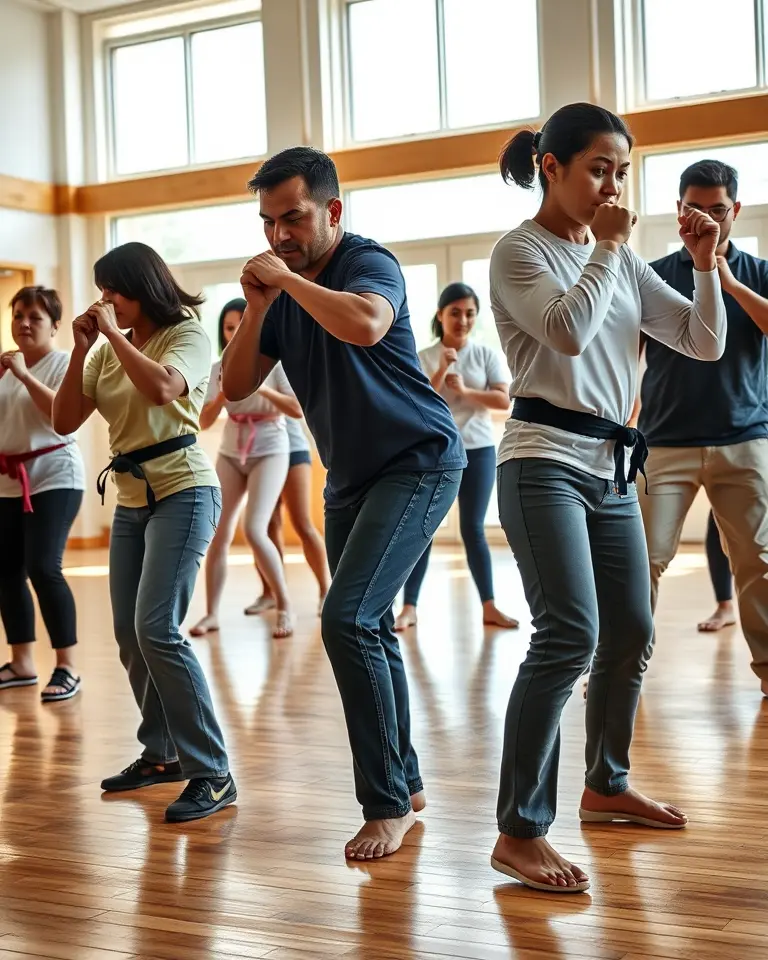Community centers across the nation are increasingly offering self-defense courses that combine crucial safety skills with physical fitness benefits. These classes, designed for individuals of all ages and fitness levels, are becoming a popular option for those looking to empower themselves while improving their physical well-being.
The Dual Benefit: Safety and Fitness
Self-defense classes offered at community centers provide a unique blend of practical safety skills and physical conditioning. Unlike traditional fitness classes, these courses teach participants how to protect themselves in potentially dangerous situations while simultaneously improving their strength, agility, and overall fitness.
Physical Fitness Aspects
The physical aspect of self-defense training is a significant draw for many. These courses typically incorporate:
- Cardiovascular workouts: Drills and exercises often involve movements that elevate the heart rate, improving cardiovascular health.
- Strength training: Participants develop strength through techniques that utilize body weight and resistance.
- Flexibility and agility: Many self-defense techniques require flexibility and quick movements, which are improved through regular practice.
- Coordination: The practice of various strikes, blocks, and movements enhances hand-eye coordination and overall body coordination.
Community centers are already equipped with fitness facilities, which often include cardiovascular and strength training equipment, making it convenient for participants to combine their self-defense training with regular gym routines. These facilities often feature treadmills, elliptical trainers, various bikes, and free weights.
Self-Defense Skills and Techniques
Beyond physical fitness, these courses focus on practical self-defense techniques. These can include:
- Awareness and avoidance: Classes often emphasize the importance of situational awareness and how to avoid dangerous situations before they escalate.
- Verbal Boundaries: Setting strong verbal boundaries is a key skill taught in self-defense to de-escalate potentially dangerous situations.
- Basic strikes: Participants learn fundamental strikes, such as palm strikes, elbow strikes, and kicks, that can be used to defend themselves.
- Escapes: Techniques to escape grabs, holds, and other types of physical attacks are a key component of self-defense courses.
- Defense Against Grabs: Participants learn essential self-defense techniques to counteract grabbing and pushing attacks. These include establishing a solid stance, protecting the head, controlling an assailant’s arm, and exploiting vulnerabilities with targeted strikes.
- Use of everyday objects: Some courses teach how to use everyday items, such as keys or bags, as tools for self-defense.
These skills are not just physical; they also build mental resilience and confidence, helping individuals feel more empowered in their daily lives.
Why Community Centers?
Community centers are uniquely positioned to offer these types of courses, making them accessible and affordable for many.
Accessibility
Community centers are generally located within local neighborhoods, providing convenient access for residents. This proximity reduces the barriers to participation, making it easier for people to attend classes regularly. Many community centers also offer a wide range of fitness classes included with a membership, or through affordable day passes, encouraging more people to participate.
Affordability
Compared to specialized martial arts studios or private self-defense training, community center courses are often more affordable, making them accessible to a broader segment of the population. This is especially important for individuals and families on a budget who want to prioritize personal safety without a large financial commitment.
Community Focus
Community centers are community hubs, fostering a sense of belonging and social interaction. Self-defense classes, in particular, can bring people together, creating a supportive environment where individuals can learn and grow together.
Who Benefits?
Self-defense courses at community centers cater to a diverse range of individuals, each gaining unique advantages.
Women’s Self-Defense
Self-defense classes are particularly beneficial for women, offering them tools to feel safer and more confident. These courses often emphasize techniques that can be used effectively regardless of physical size or strength. According to statistics, one in three women will be the victim of a violent attack in their lifetime, highlighting the importance of self-defense training. Women’s self-defense training also includes methods for preventing a confrontation from turning physical.
Teenagers
For teenagers, self-defense training can be empowering. These courses not only provide physical skills but also teach awareness and assertiveness, which are valuable in navigating social situations. Many community centers offer specific classes for teens, addressing their particular needs.
Seniors
Seniors can also benefit from self-defense training by improving their balance, flexibility, and coordination while also learning how to protect themselves. These courses are often modified to accommodate different physical abilities, ensuring that everyone can participate safely and effectively. Self-defense training for seniors can emphasize simple techniques that are easy to remember and execute.
Beginners
Community center self-defense classes often cater to beginners, providing a supportive and non-intimidating environment to learn basic skills. These courses often start with fundamental concepts, ensuring that participants build a solid foundation before advancing to more complex techniques.
Key Self-Defense Techniques
While specific techniques vary by class and instructor, there are several core self-defense moves that are commonly taught:
Palm Heel Strike
This technique involves striking with the heel of the palm, targeting vulnerable areas like the nose or throat. It’s a powerful and easy-to-learn strike, ideal for close-range situations.
Elbow Strike
The elbow strike is effective in close combat, using the sharp point of the elbow to inflict damage on an attacker. It’s particularly useful when an attacker is too close for a full punch or kick.
Groin Kick
A kick to the groin can be highly effective in incapacitating an attacker, providing an opportunity to escape. It’s a simple yet powerful technique that can be executed by individuals of all sizes.
Escape Techniques
Learning how to escape from grabs and holds is crucial for self-defense. These techniques often involve leveraging body weight and using quick movements to break free.
The Psychological Benefits
Beyond the physical aspects, self-defense training at community centers offers profound psychological benefits.
Increased Confidence
Learning to defend oneself can significantly boost self-confidence and overall self-esteem. The ability to protect oneself creates a sense of empowerment and reduces feelings of vulnerability.
Improved Mental Resilience
Self-defense training enhances mental resilience, helping individuals stay calm and focused under pressure. This mental toughness can be valuable in various life situations, not just during physical threats.
Reduced Anxiety
By equipping individuals with practical skills, self-defense classes can reduce anxiety related to personal safety. The knowledge that one can protect themselves can alleviate fears and increase a sense of security.
Finding a Class
Community centers across the country offer a variety of self-defense programs. Here are some steps you can take to find a class near you:
- Check your local community center website: Many centers list their class schedules online, making it easy to find information on self-defense programs.
- Call your local community center: A quick call to the center can provide information on current class offerings, schedules, and costs.
- Look for specific self defense classes: Some community centers offer specific self defense classes. For example, The Dublin Police Department offers a self-defense class for anyone ages 16 and older. Also, the Austin Recreation Center has free, one-day workshops introducing self-defense fundamentals.
Conclusion
Community center self-defense courses represent a valuable resource for individuals looking to enhance their safety and fitness. These classes offer practical self-defense skills, improve physical conditioning, and boost self-confidence, all within an accessible and affordable environment. As communities continue to prioritize personal safety and well-being, these courses are poised to become an increasingly vital part of local programming.







